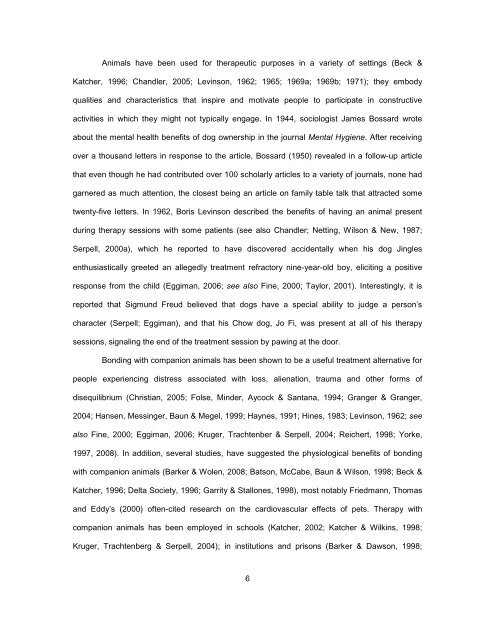A SYSTEMATIC REVIEW OF THE EFFECTS OF PSYCHOTHERAPY ...
A SYSTEMATIC REVIEW OF THE EFFECTS OF PSYCHOTHERAPY ...
A SYSTEMATIC REVIEW OF THE EFFECTS OF PSYCHOTHERAPY ...
You also want an ePaper? Increase the reach of your titles
YUMPU automatically turns print PDFs into web optimized ePapers that Google loves.
Animals have been used for therapeutic purposes in a variety of settings (Beck &<br />
Katcher, 1996; Chandler, 2005; Levinson, 1962; 1965; 1969a; 1969b; 1971); they embody<br />
qualities and characteristics that inspire and motivate people to participate in constructive<br />
activities in which they might not typically engage. In 1944, sociologist James Bossard wrote<br />
about the mental health benefits of dog ownership in the journal Mental Hygiene. After receiving<br />
over a thousand letters in response to the article, Bossard (1950) revealed in a follow-up article<br />
that even though he had contributed over 100 scholarly articles to a variety of journals, none had<br />
garnered as much attention, the closest being an article on family table talk that attracted some<br />
twenty-five letters. In 1962, Boris Levinson described the benefits of having an animal present<br />
during therapy sessions with some patients (see also Chandler; Netting, Wilson & New, 1987;<br />
Serpell, 2000a), which he reported to have discovered accidentally when his dog Jingles<br />
enthusiastically greeted an allegedly treatment refractory nine-year-old boy, eliciting a positive<br />
response from the child (Eggiman, 2006; see also Fine, 2000; Taylor, 2001). Interestingly, it is<br />
reported that Sigmund Freud believed that dogs have a special ability to judge a person’s<br />
character (Serpell; Eggiman), and that his Chow dog, Jo Fi, was present at all of his therapy<br />
sessions, signaling the end of the treatment session by pawing at the door.<br />
Bonding with companion animals has been shown to be a useful treatment alternative for<br />
people experiencing distress associated with loss, alienation, trauma and other forms of<br />
disequilibrium (Christian, 2005; Folse, Minder, Aycock & Santana, 1994; Granger & Granger,<br />
2004; Hansen, Messinger, Baun & Megel, 1999; Haynes, 1991; Hines, 1983; Levinson, 1962; see<br />
also Fine, 2000; Eggiman, 2006; Kruger, Trachtenber & Serpell, 2004; Reichert, 1998; Yorke,<br />
1997, 2008). In addition, several studies, have suggested the physiological benefits of bonding<br />
with companion animals (Barker & Wolen, 2008; Batson, McCabe, Baun & Wilson, 1998; Beck &<br />
Katcher, 1996; Delta Society, 1996; Garrity & Stallones, 1998), most notably Friedmann, Thomas<br />
and Eddy’s (2000) often-cited research on the cardiovascular effects of pets. Therapy with<br />
companion animals has been employed in schools (Katcher, 2002; Katcher & Wilkins, 1998;<br />
Kruger, Trachtenberg & Serpell, 2004); in institutions and prisons (Barker & Dawson, 1998;<br />
6
















